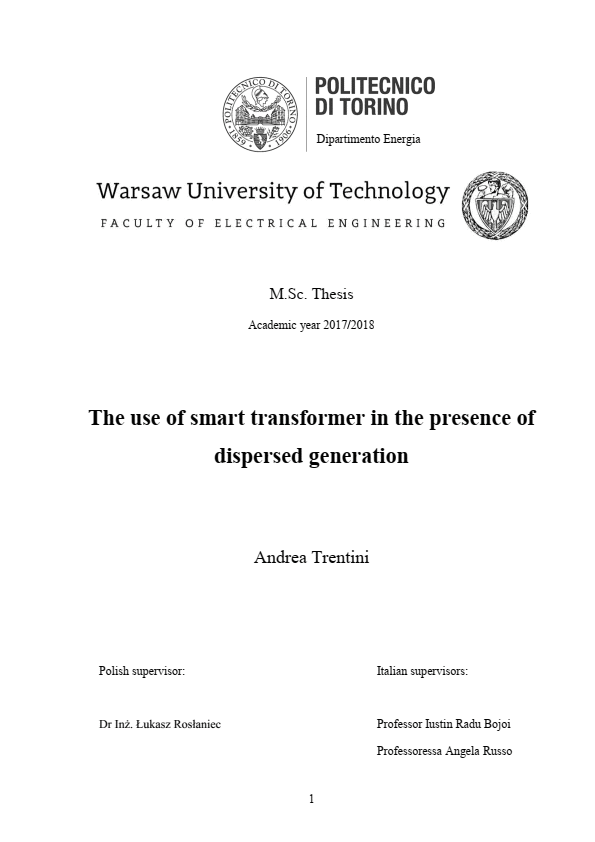Smart transformers in smart grids
High penetration of distributed energy sources in distribution network, in particular wind generation, photovoltaic systems, small cogeneration power plants (units based on the combination of the production of heat and power) causes radical change in the classic interpretation of the electricity grid.

Despite the various advantages due to this development of dispersed generation, one of the main driving force which constrain the distribution system to evolve is the possibility to obtain bidirectional power flow caused by changing profiles of loads and generations.
Therefore, this increasing role of decentralised generation may influence electrical system performances and cause severe problems such as overvoltages and undervoltages, overloads and high energy losses. For this reason advanced microgrids and especially smart grids are used in modern energy systems to integrate these technologies with energy storage systems, communication network and in particular with smart transformer devices.
Smart grids increase total efficiency of the network, reducing losses and costs, being able to monitoring, communicating and analysing every possible aspect of the grid.
In this way it is possible to allow bidirectional power flows and improving the electric power quality of the system filtering and mitigating disturbances such as flicker, sags and harmonics flowing from one side to another of the smart transformer.
Distributed energy influence
This thesis deals with the influence of distributed energy sources on the distribution network and the employment of various smart transformer topologies in order to manage the problems introduced by this kind of generation.
After a brief introduction of electric power quality (EPQ) and transmission and distribution networks it will be discussed the concept of dispersed generation in general, its advantages and disadvantages and its impact on electric power quality and on distribution network. Then, the concepts of microgrid and smart grid will be introduced, following with the aspect of smart transformer, its characteristics and advantages on the distribution network.
Different topologies of smart transformer, or devices which can be classified as smart transformer, will be analysed, describing their features and influence on electrical networks.

Technically, the aim of this thesis is to show the possibility to change a conventional transformer interfacing medium and low voltage network into a smart device which gives the possibility to control and respond to the modifications introduced in the system (especially on the voltage level) by dispersed generation.
Electric Power Quality (EPQ)
First of all, to properly understand the concept of electric power quality and dispersed generation it is necessary to introduce the concept of transmission and distribution system.
Transmission and distribution system
The electricity is produced in generating stations (principally still based on fossil fuels) at a value of tens kilovolts and then, by means of some step-up transformers, the voltage is increased from 44kV up to 765kV.
The majority of transmission lines operate in three phase alternate current, sometimes single phase is used to feed railway system. High voltages are used to minimise the losses due to the flowing of the current, in fact, increasing the voltage, keeping the same power flow, it means a reduction of current which leads to a square decrease of power losses for the Joule’s law.
Besides, the most common ways to carry the electric power are through the overhead lines or underground power cables.

Overhead lines allow the current transmission by means of non insulated conductors based on copper or aluminium. Although copper is more refined than aluminium alloy, this last material is more common because it is lighter (so easier to sustain by the steel poles) and especially less expensive; the conductor consists of many strands and it is possible to reinforce it with steel strands as well.
For these reasons aluminium alloy is the most used conductor material for overhead lines. It is also possible to encounter bundle conductors when the need of current is higher than the current capacitance of the single conductor, in this way it is possible to increase the current capacitance of the line and reduce the power losses caused by corona discharge.
There are also some operational limitations but the maintenance costs are lower than overhead lines, the cables are not visible and much less affected by the weather conditions, as they are buried underground.
One of the main use of underground transmission is in urban areas where there is no space for an overhead transmission or locations sensitive from an environmental point of view where overhead lines would badly affect the landscape and natural habitat.
Nowadays, the level of high voltage considered in the transmission network is 110kV or more (above 765 kV become extra high voltage), while lower voltage levels (like 66kV or 33kV) are considered sub transmission voltages.
| Title: | Generator protection functions and test methods – Thesis by Andrea Trentini at Politecnico di Torino |
| Format: | |
| Size: | 4.8 MB |
| Pages: | 90 |
| Download: | Right here | Video Courses | Membership | Download Updates |



I think we care about your opinions. But I suggest to keep learnership to those who study electrical engineering
I would like to read the notification of EEP